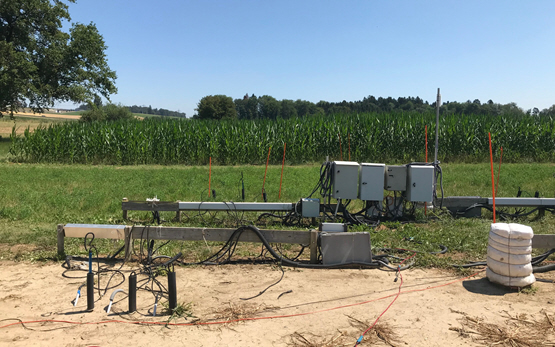Soil compaction is a phenomenon of intensified agriculture with heavy machinery, which is associated with altered soil properties and a disturbed soil structure. The SSO trial was set up in order to study the intensity, timescale and soil depth of harmful effects on soil structure as well as the latter’s regenerative capacity. The focus is on various forms of management and their impact on soil-structure formation processes. The trial is intended to shed light on how, and how quickly, compacted soils can regenerate, how this changes with soil depth, and what impact the type of management has on regeneration.

Trial Design
The trial was set up in 2013 in Zurich-Reckenholz on a deep gleyic Cambisol and was partly subjected to harmful compaction in 2014. Four plots in each of the three replication blocks are managed differently: two plots, one with a permanent meadow and one with bare fallow, remain untilled, whilst two plots undergo a rotation with or without tillage. In each treatment, three stages of compaction are tested: no compaction, track compaction or full compaction. The crop rotation includes cereals, silage maize and oilseed rape.
Measurements
A network of sensors quasi-continuously records water content, suction tension, oxygen and carbon dioxide concentration in the soil air, soil temperature, redox potential and oxygen diffusion rate up to a soil depth of 0.7 m. Additional investigations at regular time intervals include soil samplings, measurements of mechanical soil resistance and infiltration rate, geophysical measurements (ERT, seismics) and determination of agricultural-crop yields. The soil samples are analysed in the laboratory for soil physical and biological properties such as porosity, water and air permeability, gas diffusivity, microbial biomass, and macrofauna composition.
Soil damaged by compaction exhibits a reduced infiltration rate and reduced air permeability. These negative effects are long-term, and cannot be reversed by tillage. Some parameters may take longer to regenerate than others, and regeneration time increases with soil depth.
Contact
Key data
Topic: Soil structure, compaction
Site: Zurich-Reckenholz
Location: 47.430188, 8.521243;
440 m a.s.l.
Start year: 2013
Design: split-plot, 3 replications
Soil type (WRB): deep gleyic Cambisol
Soil texture: Loam (25% clay, 52% silt, 23% sand, 1.8% org. C)
Precipitation: 1050 mm
Temperature: 9.4 °C
Further Information
Last modification 17.10.2025









